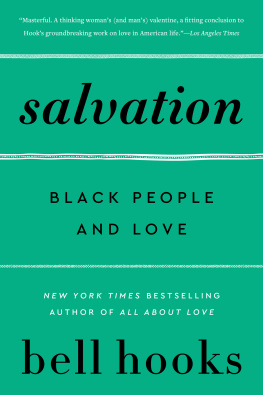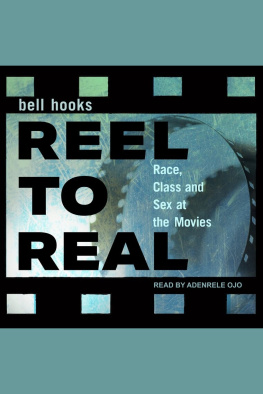First published 1994 by Routledge
First published in Routledge Classics 2006
by Routledge
270 Madison Ave, New York, NY 10016
Simultaneously published in the UK
by Routledge
2 Park Square, Milton Park, Abingdon, Oxon OX14 4RN
Reprinted 2008 (twice)
Routledge is an imprint of the Taylor & Francis Group, an informa business
1994 Gloria Watkins
Typeset in Joanna by RefineCatch Limited, Bungay, Suffolk Printed and bound in Great Britain by TJ International Ltd, Padstow, Cornwall
All rights reserved. No part of this book may be reprinted or reproduced or utilized in any form or by any electronic, mechanical, or other means, now known or hereafter invented, including photocopying and recording, or in any information storage or retrieval system, without permission in writing from the publishers.
Library of Congress Cataloging in Publication Data
A catalog record for this book has been requested
British Library Cataloguing in Publication Data
A catalogue record for this book is available from the British Library
ISBN10: 0-415-38958-5
ISBN13: 978-0-415-38958-7
2
ALTARS OF SACRIFICE
Re-membering Basquiat
Is your all on the altar of sacrifice laid?
Black church song
At the opening of the 1992 Jean-Michel Basquiat exhibition at the Whitney Museum last fall, I wandered through the crowd talking to the folks about the art. I had just one question. It was about emotional responses to the work. I asked, what did people feel looking at Basquiats paintings? No one I talked with answered the question. They went off on tangents, said what they liked about him, recalled meetings, generally talked about the show, but something seemed to stand in the way, preventing them from spontaneously articulating feelings the work evoked. If art moves us, touches our spirit, it is not easily forgotten. Images will reappear in our heads against our will. I often think that many of the works that are canonically labeled great are simply those that lingered longest in individual memory. And that they lingered because while looking at them someone was moved, touched, taken to another place, momentarily born again.
Those folks who are not moved by Basquiats work are usually unable to think of it as great or even good art. Certainly this response seems to characterize much of what mainstream art critics think about Basquiat. Unmoved, they are unable to speak meaningfully about the work. Often with no subtlety or tact, they diss the work by obsessively focusing on Basquiats life or the development of his career, all the while insisting that they are in the best possible position to judge its value and significance. (A stellar example of this tendency is Adam Gopniks 1992 piece in the New Yorker ). Undoubtedly it is a difficult task to determine the worth and value of a painters life and work if one cannot get close enough to feel anything, if indeed one can only stand at a distance.
Ironically, though Basquiat spent much of his short adult life trying to get close to significant white folks in the established art world, he consciously produced art that was a barrier, a wall between him and that world. Like a secret chamber that can only be opened and entered by those who can decipher hidden codes, Basquiats painting challenges folks who think that by merely looking they can see. Calling attention to this aspect of Basquiats style, Robert Storr has written, Everything about his work is knowing and much is about knowing. Yet the work resists knowing, offers none of the loose and generous hospitality Basquiat was willing to give freely as a person.
Designed to be a closed door, Basquiats work holds no warm welcome for those who approach it with a narrow Eurocentric gaze. That gaze which can only recognize Basquiat if he is in the company of Warhol or some other highly visible figure. That gaze which can value him only if he can be seen as part of a continuum of contemporary American art with a genealogy traced through white males; Pollock, de Kooning, Rauschenberg, Twombly, and on to Andy. Rarely does anyone connect Basquiats work to traditions in African American art history. While it is obvious that he was influenced and inspired by the work of established white male artists, the content of his work does not neatly converge with theirs. Even when Basquiat can be placed stylistically in the exclusive, white male art club that denies entry to most black artists, his subject matterhis contentalways separates him once again, and defamiliarizes him.
It is the content of his work that serves as a barrier, challenging the Eurocentric gaze that commodifies, appropriates and celebrates. In keeping with the codes of that street culture he loved so much, Basquiats work is in your face . It confronts different eyes in different ways. Looking at the work from a Eurocentric perspective, one sees and values only those aspects that mimic familiar white Western artistic traditions. Looking at the work from a more inclusive standpoint, we are all better able to see the dynamism springing from the convergence, contact, and conflict of varied traditions. Many artistic black folks I know, including myself, celebrate this inclusive dimension emphasized in an insightful discussion of his life and work by his close friend, the artist and rapper Fred Braithwaite (a.k.a. Fab 5 Freddy). In Interview , Braithwaite acknowledges the sweetness of their artistic bonding and says that it had to do with their shared openness to any influence, the pleasure they took in talking to one another about other painters as well as about the guys painting on the trains.
Basquiat was in no way secretive about the fact that he was influenced and inspired by the work of white artists. It is the multiple other sources of inspiration and influence that are submerged, lost, when critics are obsessed with seeing him as connected solely to a white Western artistic continuum. These other elements are lost precisely because they are often not seenor if seen, not understood. When art critic Thomas McEvilley suggests in Artforum that this black artist was doing exactly what classical-Modernist white artists such as Picasso and Georges Braque had done: deliberately echoing a primitive style, he erases all of Basquiats distinct connections to a cultural and ancestral memory that linked him directly to primitive traditions. This then allows McEvilley to make the absurd suggestion that Basquiat was behaving like white men who think they are behaving like black men, rather than understand that Basquiat was grappling with both the pull of a genealogy that is fundamentally black (rooted in African diasporic primitive and high art traditions) and a fascination with white Western traditions. Articulating the distance separating traditional Eurocentric art from his own history and destiny and from the collective fate of diasporic black artists and black people, Basquiats paintings testify.
To bear witness in his work, Basquiat struggled to utter the unspeakable. Prophetically called, he engaged in an extended artistic elaboration of a politics of dehumanization. In his work, colonization of the black body and mind is marked by the anguish of abandonment, estrangement, dismemberment, and death. Red paint drips like blood on his untitled painting of a black female, identified by a sign that reads Detail of Maid from Olympia. A dual critique is occurring here. First, the critique of Western imperialism and then the critique of the way in which imperialism makes itself heard, the way it is reproduced in culture and art. This image is ugly and grotesque. That is exactly how it should be. For what Basquiat unmasks is the ugliness of those traditions. He takes the Eurocentric valuation of the great and beautiful and demands that we acknowledge the brutal reality it masks.
The ugliness conveyed in Basquiat paintings is not solely the horror of colonizing whiteness; it is the tragedy of black complicity and betrayal. Works like Irony of a Negro Policeman (1981) and Quality Meats for the Public (1982) document this stance. The images are nakedly violent. They speak of dread and terror, of being torn apart and ravished. Commodified, appropriated, made to serve the interests of white masters, the black body as Basquiat shows it is incomplete, never fulfilled. And even when he is calling out the work of black stars sports figures, entertainersthere is still the portrayal of incompleteness and the message that complicity negates. These works suggest that assimilation and participation in a bourgeois white paradigm can lead to a process of self-objectification that is just as dehumanizing as any racist assault by white culture. Content to be only what the oppressors want, this black image can never be fully self-actualized. It must always be represented as fragmented. Expressing a firsthand knowledge of the way assimilation and objectification lead to isolation, Basquiats black male figures stand alone and apart; they are not whole people.
Next page














